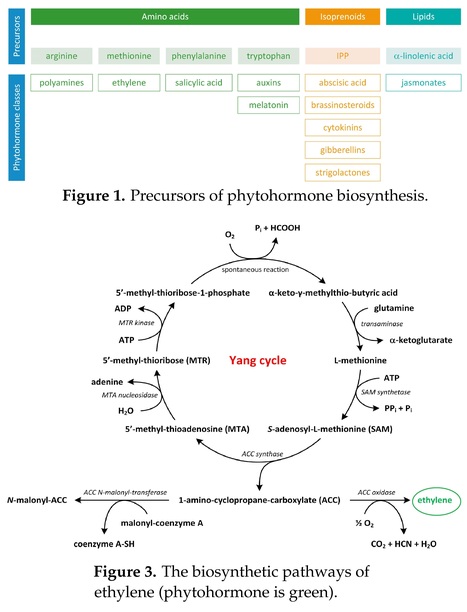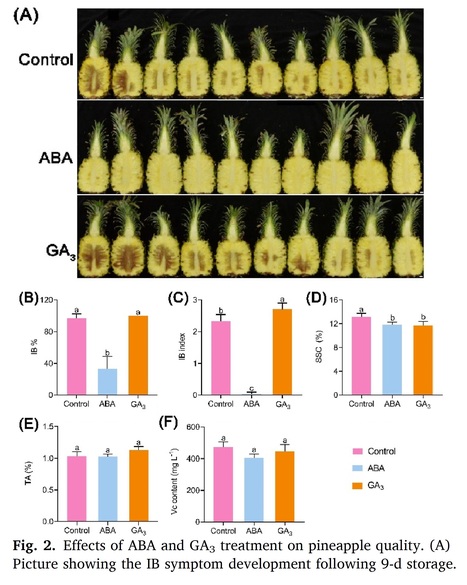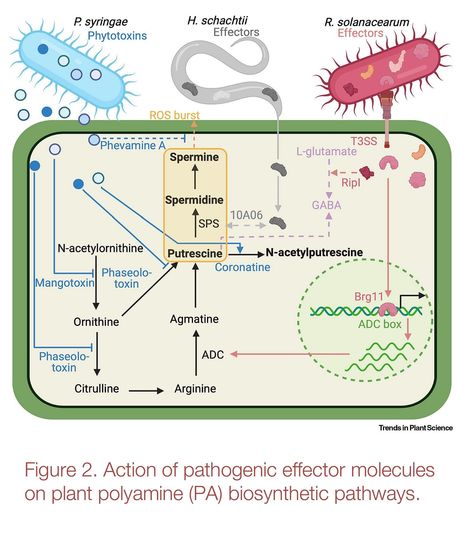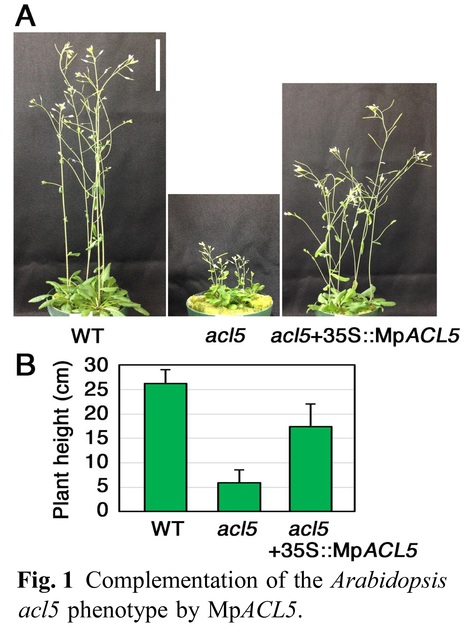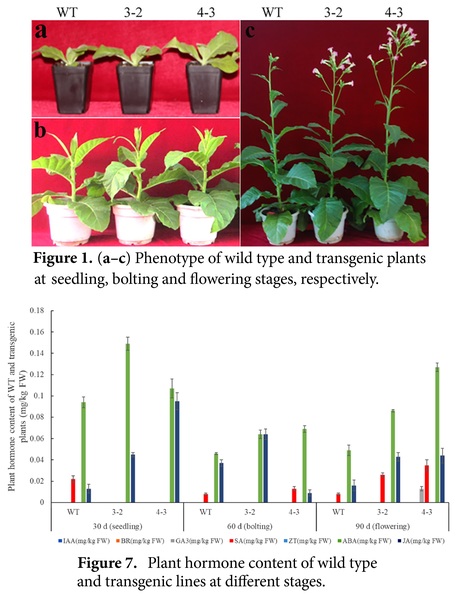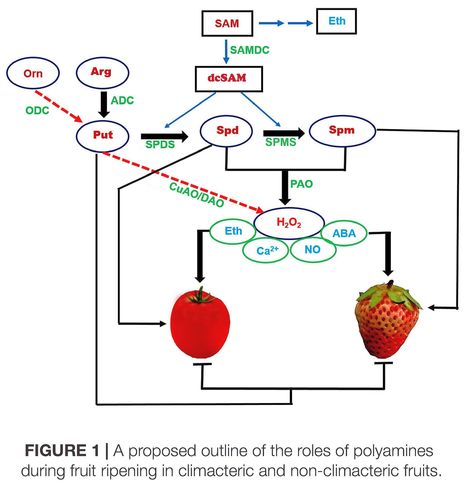 Your new post is loading...
 Your new post is loading...
Authors: Wenli Hu, Rong Wang, Xiaohua Hao, Shaozhuang Li, Xinjie Zhao, Zijing Xie, Sha Wu, Liqun Huang, Ying Tan, Lianfu Tian and Dongping Li.
The Plant Journal (2024)
Significant Statement: The results of this study provide a genetic and molecular understanding of how the OsLCD3-OsSAMS1 regulatory module regulates grain size, suggesting that ethylene/polyamine homeostasis is an appropriate target for improving grain size and weight.
Abstract: "A fundamental question in developmental biology is how to regulate grain size to improve crop yields. Despite this, little is still known about the genetics and molecular mechanisms regulating grain size in crops. Here, we provide evidence that a putative protein kinase-like (OsLCD3) interacts with the S-adenosyl-L-methionine synthetase 1 (OsSAMS1) and determines the size and weight of grains. OsLCD3 mutation (lcd3) significantly increased grain size and weight by promoting cell expansion in spikelet hull, whereas its overexpression caused negative effects, suggesting that grain size was negatively regulated by OsLCD3. Importantly, lcd3 and OsSAMS1 overexpression (SAM1OE) led to large and heavy grains, with increased ethylene and decreased polyamines production. Based on genetic analyses, it appears that OsLCD3 and OsSAMS1 control rice grain size in part by ethylene/polyamine homeostasis. The results of this study provide a genetic and molecular understanding of how the OsLCD3-OsSAMS1 regulatory module regulates grain size, suggesting that ethylene/polyamine homeostasis is an appropriate target for improving grain size and weight."
Author: Miguel A. Blázquez.
Annual Review of Plant Biology (2024)
Abstract: "This review focuses on the intricate relationship between plant polyamines and the genetic circuits and signaling pathways that regulate various developmental programs and the defense responses of plants when faced with biotic and abiotic aggressions. Particular emphasis is placed on genetic evidence supporting the involvement of polyamines in specific processes, such as the pivotal role of thermospermine in regulating xylem cell differentiation and the significant contribution of polyamine metabolism in enhancing plant resilience to drought. Based on the numerous studies describing effects of the manipulation of plant polyamine levels, two conceptually different mechanisms for polyamine activity are discussed: direct participation of polyamines in translational regulation and the indirect production of hydrogen peroxide as a defensive mechanism against pathogens. By describing the multifaceted functions of polyamines, this review underscores the profound significance of these compounds in enabling plants to adapt and thrive in challenging environments."
Authors: Takuya Furumoto, Shohei Yamaoka, Takayuki Kohchi, Hiroyasu Motose and Taku Takahashi.
Plant and Cell Physiology (2024)
Abstract: "Thermospermine suppresses auxin-inducible xylem differentiation, whereas its structural isomer, spermine, is involved in stress responses in angiosperms. The thermospermine synthase, ACAULIS5 (ACL5), is conserved from algae to land plants, but its physiological functions remain elusive in non-vascular plants. Here, we focused on MpACL5, a gene in the liverwort Marchantia polymorpha, that rescued the dwarf phenotype of the acl5 mutant in Arabidopsis. In the Mpacl5 mutants generated by genome editing, severe growth retardation was observed in the vegetative organ, thallus, and the sexual reproductive organ, gametangiophore. The mutant gametangiophores exhibited remarkable morphological defects such as short stalks, fasciation, and indeterminate growth. Two gametangiophores fused together and new gametangiophores were often initiated from the old ones. Furthermore, Mpacl5 showed altered responses to heat and salt stresses. Given the absence of spermine in bryophytes, these results suggest that thermospermine has a dual primordial function in organ development and stress responses in M. polymorpha. The stress response function may have eventually been assigned to spermine during land plant evolution."
Authors: Andrzej Bajguz and Alicja Piotrowska-Niczyporuk.
Metabolites (2023)
Abstract: "Phytohormones exhibit a wide range of chemical structures, though they primarily originate from three key metabolic precursors: amino acids, isoprenoids, and lipids. Specific amino acids, such as tryptophan, methionine, phenylalanine, and arginine, contribute to the production of various phytohormones, including auxins, melatonin, ethylene, salicylic acid, and polyamines. Isoprenoids are the foundation of five phytohormone categories: cytokinins, brassinosteroids, gibberellins, abscisic acid, and strigolactones. Furthermore, lipids, i.e., α-linolenic acid, function as a precursor for jasmonic acid. The biosynthesis routes of these different plant hormones are intricately complex. Understanding of these processes can greatly enhance our knowledge of how these hormones regulate plant growth, development, and physiology. This review focuses on detailing the biosynthetic pathways of phytohormones."
Authors: Qian Li, Guang Wang, Siting Lai and Shijiang Zhu.
LWT - Food Science and Technology (2023)
Highlights • Pineapples display internal browning and reduced spermidine (Spd) after storage. • ABA alleviates internal browning and GA3 aggravates internal browning. • ABA enhances Spd synthesis, while GA3 does not obviously affect it. • Exogenous application of Spd reduces pineapple internal browning. • The findings suggest Spd plays an important role in regulating internal browning.
Abstract: "Spermidine is one of the secondary metabolites (SM) related to plant tissue browning caused by chilling, but whether it plays a role in pineapple internal browning (IB) occurred at ambient temperature remains unknown. In this study, pineapples affected by severe IB after 9-d storage showed dramatic changes in SMs, with 94.94% of 79 being upregulated. Among the 4 downregulated were spermidine. Exogenous abscisic acid (ABA) suppressed and gibberellin (GA3) aggravated IB and they differentially regulated SMs and spermidine. Compared with the control, ABA downregulated 65 of 70 SMs and upregulated spermidine, while GA3 upregulated 7 of 24 SMs and did not obviously affect spermidine. Exogenous spermidine alleviated IB, confirming the role of spermidine in regulating IB. ABA upregulated spermidine biosynthesis genes AcARG1 and AcSPDS, while GA3 upregulated AcPAO2. ABA downregulated and GA3 upregulated SAM, ACS and ACO. ABA reduced 1-aminocyclopropane 1-Carboxylate (ACC) and GA3 did not. ABA upregulated NCED, ABA2 and AAO3 and increased endogenous ABA, while GA3 showed opposite effects. Collectively, the findings indicate spermidine play an important role in regulating IB of pineapple. Moreover, this work may provide novel insight into the mechanism underlying interactions of spermidine with ABA and GA in regulating quality of harvested fruit."
Authors: Anshika Tyagi, Sajad Ali, Goriparthi Ramakrishna, Anupam Singh, Suvin Park, Henda Mahmoudi and Hanhong Bae.
Journal of Plant Growth Regulation (2023)
Abstract: "Phytohormone-like plant growth regulators are becoming hallmarks in plant stress biology since they can offer incredible benefits to plants, such as increased crop output, improved growth features and stress tolerance. Among them polyamines (PAs) such as putrescine (Put), spermidine (Spd), and spermine (Spm), are recognized as important bio-stimulants that can boost plant growth, productivity, and stress tolerance, whether provided exogenously or synthesized endogenously by genetically engineered plants. However, the precise mechanism by which they regulate plant development and stress responses and their interactions with other signaling molecules remains unknown. Hence, unravelling the molecular complexity of PAs signaling in plants can help us to improve crop stress resistance and yield. This review focuses on the distribution, biosynthesis, and role of PAs in plant growth and development, abiotic stress tolerance, and the involvement of a possible novel interlinked signaling cascade between them. Further, we focused on our current understanding and knowledge gaps of how PAs interact with other signaling molecules like hormones and nitric oxide (NO) to regulate plant growth and stress tolerance in a coordinated manner. We also provide an overview of PA signaling in plants, focusing on calcium (Ca2+) and reactive oxygen species (ROS) under abiotic stress, and some key insights into omics and nanotechnology approach for future research."
Authors: Xilong Li, Zongyun Yan, Meiling Zhang, Jiayin Wang, Peiyong Xin, Shujing Cheng, Liquan Kou, Xiaoting Zhang, Songlin Wu, Jinfang Chu, Chengqi Yi, Keqiong Ye, Bing Wang and Jiayang Li.
Science China Life Sciences (2022)
Abstract: "Polyamines have been discovered for hundreds of years and once considered as a class of phytohormones. Polyamines play critical roles in a range of developmental processes. However, the molecular mechanisms of polyamine signaling pathways remain poorly understood. Here, we measured the contents of main types of polyamines, and found that endogenous level of thermospermine (T-Spm) in Arabidopsis thaliana is comparable to those of classic phytohormones and is significantly lower than those of putrescine (Put), spermidine (Spd), and spermine (Spm). We further found a nodule-like structure around the junction area connecting the shoot and root of the T-Spm biosynthetic mutant acl5 and obtained more than 50 suppressors of acl5nodule structure (san) through suppressor screening. An in-depth study of two san suppressors revealed that NAP57 and NOP56, core components of box H/ACA and C/D snoRNPs, were essential for T-Spm-mediated nodule-like structure formation and plant height. Furthermore, analyses of rRNA modifications showed that the overall levels of pseudouridylation and 2′-O-methylation were compromised in san1 and san2 respectively. Taken together, these results establish a strong genetic relationship between rRNA modification and T-Spm-mediated growth and development, which was previously undiscovered in all organisms."
Authors: Núria Vall-llaura, Rosario Torres, Neus Teixidó, Josep Usall and Jordi Giné-Bordonaba
Scientia Horticulturae (2022)
Highlights: • Ethylene dictates fruit development/ripening and response to a/biotic stresses. • Ethylene arising from the peach-Monilinia spp. depends on the fruit developmental stage. • The species and virulence of Monilinia are key determining ethylene modulation/response. • Monilinia spp. produce ethylene under certain growing conditions. • An interplay exists between ethylene, ROS and polyamines during host-pathogen interactions.
Abstract: "It is already well known that ethylene plays a crucial role in peach fruit growth and ripening, by triggering an unset of biochemical and physiological changes that finally make the fruit attractive for consumption. This said, ethylene is not only responsible for fruit ripening but, in conjunction with other hormones, or key compounds (ROS, polyamines, etc.) is involved in the plant response to numerous abiotic stresses (drought, salt and heat tolerance) as well as the plant/fruit response against certain pathogens. Among peaches, one of the most devastating pathogens is the brown rot causing fungus Monilinia spp. that can affect the fruit both on the field or postharvest. Nonetheless scarce information exists regarding the Monilinia-peach interaction from a physiological and molecular perspective. In this sense, recent studies point out to the importance of ethylene during such interaction, which seems to be dependent on the fruit developmental stage and also on the Monilinia species or even the strain's virulence. Why the fruit or the fungus reacts different to distinct Monilinia species or strains and why such reaction depends on the fruit physiological stage is, however, still elusive. Accordingly, this review aims to shed light on the role of ethylene, alone or through a complex cross-talk with other compounds, not only during peach development and ripening but also during the Monilinia-peach interaction. Based on the available literature, it is clear that not only ethylene biosynthesis but ethylene signaling and the activation of ethylene response factors via ROS may play an essential role during this specific host-pathogen interaction."
Authors: Léo Gerlin, Caroline Baroukh and Stéphane Genin.
Trends in Plant Science (2021)
Highlights: Polyamines (PAs) are a relatively overlooked component of the bacterial and plant metabolomes. The multiple roles of PAs have blurred our understanding of the function of these molecules in the context of plant–pathogen interactions. Plant PAs are involved in plant immunity, because they serve as essential modulators of the redox status of the cell, contributing to potentiation of the oxidative burst as well as the synthesis of other antimicrobial compounds. Perturbation of plant PA homeostasis appears as a common strategy of pathogens during infection. Several mechanisms involving pathogen effectors and phytotoxins lead to manipulation of plant PA biosynthetic pathways, although the outcome of these actions may have different purposes.
Abstract: "Polyamines (PAs) are ubiquitous amine molecules found in all living organisms. In plants, beside their role in signaling and protection against abiotic stresses, there is increasing evidence that PAs have a major role in the interaction between plants and pathogens. Plant PAs are involved in immunity against pathogens, notably by amplifying pattern-triggered immunity (PTI) responses through the production of reactive oxygen species (ROS). In response, pathogens use phytotoxins and effectors to manipulate the levels of PAs in the plant, most likely to their own benefit. It also appears that pathogenic microorganisms produce PAs during infection, sometimes in large quantities. This may reflect different infectious strategies based on the selective exploitation of these molecules and the functions they perform in the cell."
Authors: Ahmed M. Hashem, Simon Moore, Shangjian Chen, Chenchen Hu, Qing Zhao, Ibrahim Eid Elesawi, Yanni Feng, Jennifer F. Topping, Junli Liu, Keith Lindsey and Chunli Chen.
International Journal on Molecular Sciences (2021)
Abstract: "Polyamines (PAs) dramatically affect root architecture and development, mainly by unknown mechanisms; however, accumulating evidence points to hormone signaling and reactive oxygen species (ROS) as candidate mechanisms. To test this hypothesis, PA levels were modified by progressively reducing ADC1/2 activity and Put levels, and then changes in root meristematic zone (MZ) size, ROS, and auxin and cytokinin (CK) signaling were investigated. Decreasing putrescine resulted in an interesting inverted-U-trend in primary root growth and a similar trend in MZ size, and differential changes in putrescine (Put), spermidine (Spd), and combined spermine (Spm) plus thermospermine (Tspm) levels. At low Put concentrations, ROS accumulation increased coincidently with decreasing MZ size, and treatment with ROS scavenger KI partially rescued this phenotype. Analysis of double AtrbohD/F loss-of-function mutants indicated that NADPH oxidases were not involved in H2O2 accumulation and that elevated ROS levels were due to changes in PA back-conversion, terminal catabolism, PA ROS scavenging, or another pathway. Decreasing Put resulted in a non-linear trend in auxin signaling, whereas CK signaling decreased, re-balancing auxin and CK signaling. Different levels of Put modulated the expression of PIN1 and PIN2 auxin transporters, indicating changes to auxin distribution. These data strongly suggest that PAs modulate MZ size through both hormone signaling and ROS accumulation in Arabidopsis."
|
Authors: Chunyu Shang, Xiaoyan Liu, Guo Chen, Guobin Li, Songshen Hu, Hao Zheng, Lei Ge, Yanghao Long, Qiaomei Wang and Xiaohui Hu.
The Plant Journal (2024)
Significance Statement: In brief, in the presence of saline-alkali stress, the concentration of tomato JA is increased, acting as a signaling molecule to induce the expression of SlWRKY81 while repressing the expression of SlJAZ1. At the protein level, SlJAZ1 interacts with SlWRKY81, and the suppression of SlJAZ1 expression results in the release of additional SlWRKY81. Simultaneously, SlWRKY81 actively regulates the downstream genes SlSPDS2 and SlNHX4, promoting the synthesis of Spd and the maintenance of Na+/K+ homeostasis, thereby displaying a favorable response to saline-alkali stress. Saline-alkali stress increased JA content in tomato, which promoted the expression of SlWRKY80 and increased the regulation of downstream SlSPDS2 and SlNHX4. On the one hand, an increase in JA content inhibits the expression of SlJAZ1 (the interaction between SlJAZ1 protein and SlWRKY80 protein), releases more SlWRKY80 protein, strengthens the regulation of downstream SlSPDS2 and SlNHX4, synthesizes Spd and promotes ion balance, thereby positively regulating saline-alkali stress.
Abstract: "Saline-alkali stress is an important abiotic stress factor affecting tomato (Solanum lycopersicum L.) plant growth. Although the involvement of the tomato SlWRKY gene family in responses to saline-alkali stress has been well established, the mechanism underlying resistance to saline-alkali stress remains unclear. In this study, we investigated the role of SlWRKY81 in conferring saline-alkali stress resistance by using overexpression and knockout tomato seedlings obtained via genetic modification. We demonstrated that SlWRKY81 improves the ability of tomato to withstand saline-alkali stress by enhancing antioxidant capacity, root activity, and proline content while reducing malondialdehyde levels. Saline-alkali stress induces an increase in jasmonic acid (JA) content in tomato seedlings, and the SlWRKY81 promoter responds to JA signaling, leading to an increase in SlWRKY81 expression. Furthermore, the interaction between SlJAZ1 and SlWRKY81 represses the expression of SlWRKY81. SlWRKY81 binds to W-box motifs in the promoter regions of SlSPDS2 and SlNHX4, thereby positively regulating their expression. This regulation results in increased spermidine (Spd) content and enhanced potassium (K+) absorption and sodium (Na+) efflux, which contribute to the resistance of tomato to saline-alkali stress. However, JA and SlJAZ1 exhibit antagonistic effects. Elevated JA content reduces the inhibitory effect of SlJAZ1 on SlWRKY81, leading to the release of additional SlWRKY81 protein and further augmenting the resistance of tomato to saline-alkali stress. In summary, the modulation of Spd synthesis and Na+/K+ homeostasis mediated by the interaction between SlWRKY81 and SlJAZ1 represents a novel pathway underlying tomato response to saline-alkali stress."
Authors: Yaroslav S. Kolesnikov, Serhii V. Kretynin, Roberta Filepova, Peter I. Dobrev, Jan Martinec and Volodymyr S. Kravets.
Phytochemistry Reviews (2024)
Abstract: "In the present review, we concentrated on primary signaling and regulatory events in plant cells that are rapidly evoked in response to extracellular polyamines in vivo and induce cellular and biochemical responses. Downstream pathways that allow polyamines to regulate plant growth, development, and stress tolerance are analyzed. The results of the recent studies on polyamine metabolism and its regulatory mechanisms are also discussed. Taken together, the data suggest that endogenously and exogenously regulated polyamines by activating ion transport, calcium dynamics, lipid, protein kinase, protein conjugation, and nucleic acid regulation mechanisms modulate downstream transcriptomic, proteomic, metabolomic, and hormonal pathways affecting growth, development, and stress tolerance.
Authors: János Urbancsok, Evgeniy N. Donev, Pramod Sivan, Elena van Zalen, Félix R. Barbut, Marta Derba-Maceluch, Jan Šimura, Zakiya Yassin, Madhavi L. Gandla, Michal Karady, Karin Ljung, Sandra Winestrand, Leif J. Jönsson, Gerhard Scheepers, Nicolas Delhomme, Nathaniel R. Street and Ewa J. Mellerowicz.
New Phytologist (2023)
Abstract: "Stem bending in trees induces flexure wood but its properties and development are poorly understood. Here, we investigated the effects of low-intensity multidirectional stem flexing on growth and wood properties of hybrid aspen, and on its transcriptomic and hormonal responses. Glasshouse-grown trees were either kept stationary or subjected to several daily shakes for 5 wk, after which the transcriptomes and hormones were analyzed in the cambial region and developing wood tissues, and the wood properties were analyzed by physical, chemical and microscopy techniques. Shaking increased primary and secondary growth and altered wood differentiation by stimulating gelatinous-fiber formation, reducing secondary wall thickness, changing matrix polysaccharides and increasing cellulose, G- and H-lignin contents, cell wall porosity and saccharification yields. Wood-forming tissues exhibited elevated jasmonate, polyamine, ethylene and brassinosteroids and reduced abscisic acid and gibberellin signaling. Transcriptional responses resembled those during tension wood formation but not opposite wood formation and revealed several thigmomorphogenesis-related genes as well as novel gene networks including FLA and XTH genes encoding plasma membrane-bound proteins. Low-intensity stem flexing stimulates growth and induces wood having improved biorefinery properties through molecular and hormonal pathways similar to thigmomorphogenesis in herbaceous plants and largely overlapping with the tension wood program of hardwoods."
Authors: Takuya Furumoto, Shohei Yamaoka, Takayuki Kohchi, Hiroyasu Motose and Taku Takahashi.
bioRxiv (2023)
Abstract: "Thermospermine, a structural isomer of spermine, suppresses auxin-inducible xylem differentiation, whereas spermine is implicated in stress responses in angiosperms. Thermospermine synthase ACAULIS5 (ACL5) is well conserved from algae to land plants, but its physiological function remains elusive in non-vascular plants. Here we focused on MpACL5, a gene in the liverwort Marchantia polymorpha, which rescued the dwarf phenotype of the acl5 mutant of Arabidopsis. In the Mpacl5 mutants generated by genome editing, growth of the vegetative organ, thallus, and the sexual reproductive organ, gametangiophore, was severely retarded. The mutant gametangiophore exhibited remarkable morphological defects such as short stalks, fasciation, and indeterminate growth; it was formed as a fusion of two gametangiophores and a new gametangiophore was often initiated from the old one. Furthermore, Mpacl5 was shown to be hypersensitive to heat and salt stresses. Given the absence of spermine in liverworts including M. polymorpha, these results reveal that thermospermine has a dual primordial function in organ development and stress responses in the basal land plant lineage, the latter of which may have eventually been assigned to spermine during the land plant evolution."
Authors: Xu-Dong Liu, Yuan-Yuan Zeng, Xia-Yi Zhang, Xue-Qian Tian, Md. Mahadi Hasan, Guang-Qian Yao and Xiang-Wen Fang.
Physiologia Plantarum (2023)
Abstract: "Stomatal closure is regulated by plant hormones and some small molecules to reduce water loss under stress conditions. Both abscisic acid (ABA) and polyamines alone induce stomatal closure; however, whether the physiological functions of ABA and polyamines are synergistic or antagonistic with respect to inducing stomatal closure is still unknown. Here, stomatal movement in response to ABA and/or polyamines was tested in Vicia faba and Arabidopsis thaliana, and the change in the signalling components under stomatal closure was analysed. We found that both polyamines and ABA could induce stomatal closure through similar signalling components, including the synthesis of hydrogen peroxide (H2O2) and nitric oxide (NO) and the accumulation of Ca2+. However, polyamines partially inhibited ABA-induced stomatal closure both in epidermal peels and in planta by activating antioxidant enzymes, including superoxide dismutase (SOD), peroxidase (POD) and catalase (CAT), to eliminate the ABA-induced increase in H2O2. These results strongly indicate that polyamines inhibit abscisic acid-induced stomatal closure, suggesting that polyamines could be used as potential plant growth regulators to increase photosynthesis under mild drought stress."
Authors: Huaifeng Gao, Xuelian Wu, Xiaoqing Yang, Maoxiang Sun, Jiahui Liang, Yuansong Xiao and Futian Peng.
Frontiers in Plant Science (2022)
Abstract: "Silicon is a beneficial element for plant growth, as well as for improving plant resistance to multiple biotic and abiotic stresses. Gummosis is a common harmful disease in peach and is induced by many factors. However, the effect of silicon on gummosis of peach has not been determined yet. In this study, we reported that application of silicon significantly reduced gummosis by regulating biosynthesis of ethylene and polyamines in peach. Ethylene promoted the development of gummosis by inducing the expression of genes encoding cell wall degrading enzymes. While application of different types of polyamines, including spermidine and spermine, dramatically inhibited the occurrence of gummosis. Moreover, polyamines inhibited the ethylene biosynthesis by down-regulating expression of ethylene biosynthetic gene PpACS1 (1-aminocyclopropane -1-carboxylic acid synthase), as well as the enzymatic activity of ACS. We further found that application of silicon significantly restricted the development of gummosis in peach. Exogenous silicon dramatically inhibited expression of PpACS1 and the enzymatic activity of its product to reduce ethylene biosynthesis. Simultaneously, the activity of S-adenosylmethionine decarboxylase, a key enzyme in polyamines biosynthesis, was increased by 9.85% under silicon treatment, resulting in elevated accumulation of polyamines. Thus, our data proved that application of silicon restricted gummosis development by activating polyamines biosynthesis and inhibiting ethylene synthesis in peach."
Authors: Xinqi Cheng, Fangqin Pang, Wengang Tian, Xinxin Tang, Lan Wu, Xiaoming Hu and Huaguo Zhu
Scientific Reports (2022)
Abstract: "In previous study, ectopic expression of GhSAMDC1 improved vegetative growth and early flowering in tobacco, which had been explained through changes of polyamine content, polyamines and flowering relate genes expression. To further disclose the transcript changes of ectopic expression of GhSAMDC1 in tobacco, the leaves from wild type and two transgenic lines at seedling (30 days old), bolting (60 days old) and flowering (90 days old) stages were performed for transcriptome analysis. Compared to wild type, a total of 938 differentially expressed genes (DEGs) were found to be up- or down-regulated in the two transgenic plants. GO and KEGG analysis revealed that tobacco of wild-type and transgenic lines were controlled by a complex gene network, which regulated multiple metabolic pathways. Phytohormone detection indicate GhSAMDC1 affect endogenous phytohormone content, ABA and JA content are remarkably increased in transgenic plants. Furthermore, transcript factor analysis indicated 18 transcript factor families, including stress response, development and flowering related transcript factor families, especially AP2-EREBP, WRKY, HSF and Tify are the most over-represented in those transcript factor families. In conclusion, transcriptome analysis provides insights into the molecular mechanism of GhSAMDC1 involving rapid vegetative growth and early flowering in tobacco."
Authors: Anish Kundu, Shruti Mishra, Pritha Kundu, Abhimanyu Jogawat and Jyothilakshmi Vadassery.
Plant Physiology (2021)
Abstract: "Growth promotion induced by the endosymbiont Piriformospora indica has been observed in various plants; however, except growth phytohormones, specific functional metabolites involved in P. indica-mediated growth promotion are unknown. Here, we used a GC-MS based untargeted metabolite analysis to identify tomato (Solanum lycopersicum) metabolites whose levels were altered during P. indica-mediated growth promotion. Metabolomic multivariate analysis revealed several primary metabolites with altered levels, with putrescine induced most significantly in roots during the interaction. Further, our results indicated that P. indica modulates the arginine decarboxylase (ADC)-mediated putrescine biosynthesis pathway via induction of SlADC1 in tomato. P. indica did not promote growth in Sladc1-VIGS (virus-induced gene silencing of SlADC1) lines of tomato tomato and showed less colonization. Furthermore, using LC-MS/MS we showed that putrescine promoted growth by elevation of auxin (indole-3-acetic acid) and gibberellin (GA4, GA7) levels in tomato. In Arabidopsis (Arabidopsis thaliana) adc knock-out mutants, P. indica colonization also decreased and showed no plant growth promotion, and this response was rescued upon exogenous application of putrescine. Putrescine is also important for hyphal growth of P. indica, indicating that it is co-adapted by both host and microbe. Taken together, we conclude that putrescine is an essential metabolite and its biosynthesis in plants is crucial for P. indica-mediated plant growth promotion and fungal growth."
Authors: Ilaria Fraudentali, Renato A. Rodrigues-Pousada, Riccardo Angelini, Sandip A. Ghuge and Alessandra Cona.
International Journal of Molecular Sciences (2021)
Abstract: "Polyamines are ubiquitous, low-molecular-weight aliphatic compounds, present in living organisms and essential for cell growth and differentiation. Copper amine oxidases (CuAOs) oxidize polyamines to aminoaldehydes releasing ammonium and hydrogen peroxide, which participates in the complex network of reactive oxygen species acting as signaling molecules involved in responses to biotic and abiotic stresses. CuAOs have been identified and characterized in different plant species, but the most extensive study on a CuAO gene family has been carried out in Arabidopsis thaliana. Growing attention has been devoted in the last years to the investigation of the CuAO expression pattern during development and in response to an array of stress and stress-related hormones, events in which recent studies have highlighted CuAOs to play a key role by modulation of a multilevel phenotypic plasticity expression. In this review, the attention will be focused on the involvement of different AtCuAOs in the IAA/JA/ABA signal transduction pathways which mediate stress-induced phenotypic plasticity events."
Authors: Fan Gao, Xurong Mei, Yuzhong Li, Jiaxuan Guo and Yuanyue Shen.
Frontiers in Plant Science (2021)
Abstract: "Ripening of fleshy fruits involves complex physiological, biochemical, and molecular processes that coincide with various changes of the fruit, including texture, color, flavor, and aroma. The processes of ripening are controlled by ethylene in climacteric fruits and abscisic acid (ABA) in non-climacteric fruits. Increasing evidence is also uncovering an essential role for polyamines (PAs) in fruit ripening, especially in climacteric fruits. However, until recently breakthroughs have been made in understanding PA roles in the ripening of non-climacteric fruits. In this review, we compare the mechanisms underlying PA biosynthesis, metabolism, and action during ripening in climacteric and non-climacteric fruits at the physiological and molecular levels. The PA putrescine (Put) has a role opposite to that of spermidine/spermine (Spd/Spm) in cellular metabolism. Arginine decarboxylase (ADC) is crucial to Put biosynthesis in both climacteric and non-climacteric fruits. S-adenosylmethionine decarboxylase (SAMDC) catalyzes the conversion of Put to Spd/Spm, which marks a metabolic transition that is concomitant with the onset of fruit ripening, induced by Spd in climacteric fruits and by Spm in non-climacteric fruits. Once PA catabolism is activated by polyamine oxidase (PAO), fruit ripening and senescence are facilitated by the coordination of mechanisms that involve PAs, hydrogen peroxide (H2O2), ABA, ethylene, nitric oxide (NO), and calcium ions (Ca2+). Notably, a signal derived from PAO5-mediated PA metabolism has recently been identified in strawberry, a model system for non-climacteric fruits, providing a deeper understanding of the regulatory roles played by PAs in fleshy fruit ripening."
|




 Your new post is loading...
Your new post is loading...



